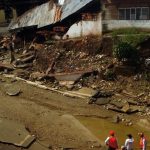Caribbean lost $741m in tourism revenue from 2017 storms: report
Last year’s devastating storms in the Caribbean cost the region an estimated 741 million US dollars in lost tourism revenue as well as more than 800,000 visitors, a new report says.
The report by the World Travel and Tourism Council (WTTC) was released as the region prepares for the start of the new hurricane season in a month’s time.
Hurricanes Irma and Maria barreled through the Caribbean last September, devastating several islands in one of the most tourism-dependent areas of the world, following which the London-based travel body carried out an analysis of the impact.
“Results from the analysis indicate that the hurricane season resulted in a likely loss of 826,100 international overnight visitors to the Caribbean in 2017 – 2.5 percent of the region’s expected visitor numbers,” the report says. “This equates to a loss of approximately US$741 million in visitor spending which would have created US$292.5 million in GDP and supported 11,005 jobs.”
What’s more, the report suggests that recovery to previous levels across affected territories could take up to four years, and if that is the case, the region will miss out on a total of over three billion US dollars.
Last year was characterized as an above-average Atlantic hurricane season with 12 named storms that wrecked parts of the Caribbean, Central America and the United States. More than 100 died as a result and the US National Oceanic and Atmospheric Administration estimates that overall an estimated 200 billion US dollars in damage was caused in the Americas.
More of the same is expected in 2018 – the season runs from June 1 to November 30 – with Colorado State University researchers, in their latest report, forecasting seven hurricanes and 14 named storms. When it comes to the Caribbean, researchers say there is a 52 percent probability (the average for last century is 42 percent) that at least one major hurricane will move through the region.
The WTTC report warns that natural disasters will continue to hit the Caribbean and elsewhere, “perhaps on an increasingly frequent basis because of climate change.”
In many Caribbean countries, tourism represents more than 25 percent of GDP, more than twice the global average, so a direct hit, or even a glancing blow, can have damaging consequences, and not only for nations in a storm’s path.
More than two-thirds of the sun-kissed islands were actually untouched by Irma and Maria but some of them also suffered because of what the WTTC report notes was a harmful public misperception internationally that the entire Caribbean was struck. At the same time, some unscathed territories may have benefited from increased business as a result of the misery of their neighbors. For example, the Cayman Islands, St. Lucia and St. Vincent and the Grenadines experienced double-digit visitor growth above expectations.
Cuba, Puerto Rico and the Dominican Republic sustained the most losses from hurricane damage in terms of total visitors and spending, although Dominica, and the US and British Virgin Islands experienced the largest percentage-wise.
Even as international development agencies urge the Caribbean to diversify their economies, the report says dependence on tourism is actually growing. In 20 of the 21 countries analyzed by the WTTC, the sector’s share of the economy actually rose for six consecutive years to 2016.
Given this picture, the WTTC outlines a series of recommendations to aid tourism resilience and recovery in the region. It said that, among other things, governments should raise duty-free exemptions on commonly purchased goods, ease work permit rules for “specialized services,” “increase access to capital” for small businesses and improve the “ease and experience” for arriving and departing travelers.
IMAGES:
Losses were also sustained by industry workers such as beach vendors who had little or no business in the worst affected territories. /VCG photo
Scientists have predicted stronger hurricanes may result from climate change. /VCG photo
Images like this damaged road in the Dominican Republic spread alarm among international tourists. /Xinhua Photo
For more on this story go to: https://news.cgtn.com/news/3d3d514d796b544d77457a6333566d54/share_p.html









